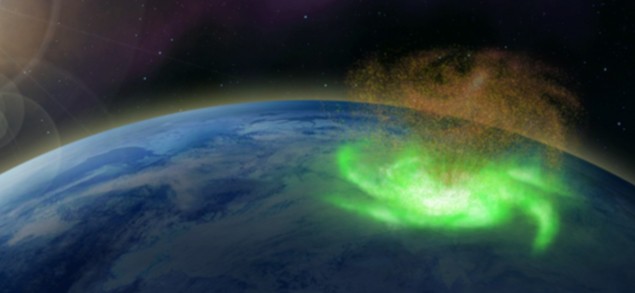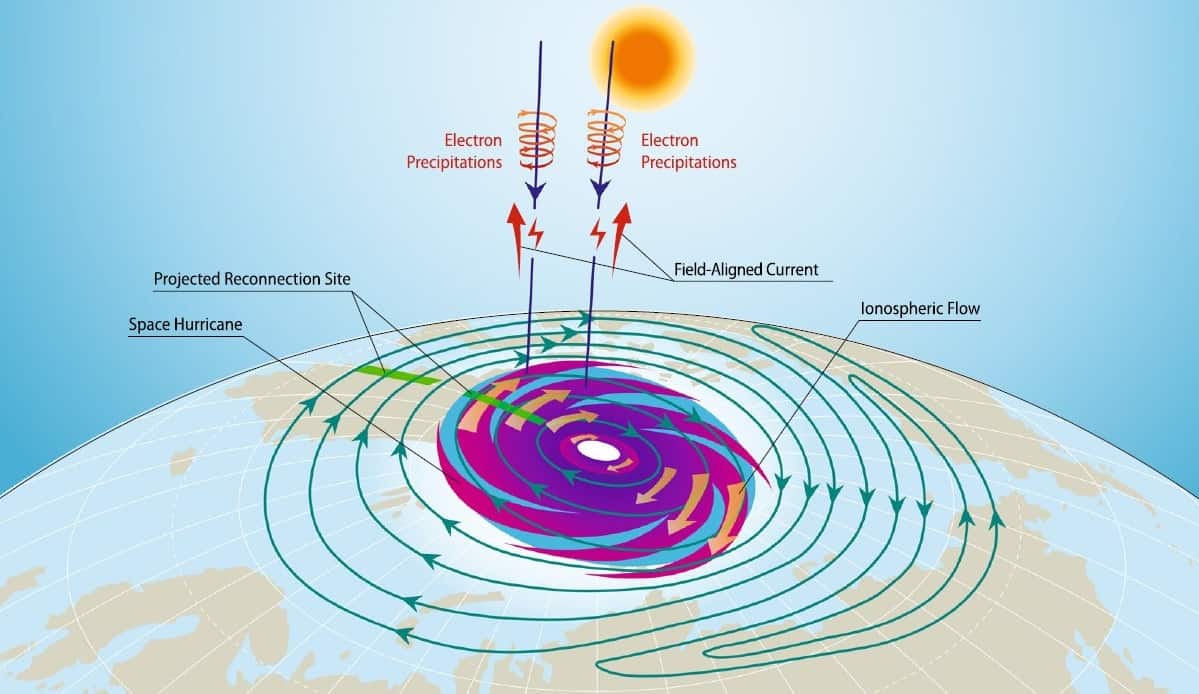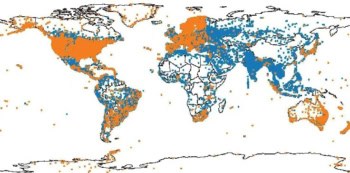
A space hurricane – complete with electron “rain” – has been detected in the Earth’s upper atmosphere for the first time, an international team of researchers has reported. With the requisite plasma and magnetic fields needed for such storms present in the atmospheres of planets across the universe, the researchers suggest that such phenomena should be commonplace.
The hurricanes with which we are more familiar form in the Earth’s lower atmosphere over warm bodies of water. As warm, moist air rises, it creates a pocket of low pressure near the ocean’s surface, which in turn sucks in the surrounding air, generating strong winds and creating clouds that lead eventually to heavy rainfall. As a result of the Coriolis effect, the inward rushing air is deflected on a circular path – forming the characteristic spiral shape of a tropical storm.
Hurricanes have also been spotted in the lower atmospheres of our neighbouring planets of Mars, Jupiter and Saturn, while similar phenomena – so-called “solar tornados” – have even been spotted churning the surface of the Sun. However, such swirling masses had never before been detected in the upper atmosphere of a planet.
The space hurricane in question was recorded above the North Pole, some several hundred kilometres up into the ionosphere, back in August 2014 by four satellites in the US Defense Meteorological Satellite Program. However, it was only revealed in the data by recent retrospective analysis led by researchers from China’s Shandong University.
Using three-dimensional magnetospheric modelling, the team was able to create an image of the phenomenon – a swirling, 1000-km-wide funnel composed not of air, but plasma. It rotated around in an anti-clockwise direction, sported multiple spiral arms, had a calm “eye” at its centre and lasted for a duration of around eight hours before gradually breaking down.
“Until now, it was uncertain that space plasma hurricanes even existed, so to prove this with such a striking observation is incredible,” says paper author and space scientist Mike Lockwood of the University of Reading. “Tropical storms are associated with huge amounts of energy, and these space hurricanes must be created by unusually large and rapid transfer of solar wind energy and charged particles into the Earth’s upper atmosphere.”
Based on their model, the team believe that the phenomena formed as the result of interactions between incoming solar wind and the Earth’s magnetic field. Notably, the hurricane appeared during a period of low solar and geomagnetic activity – with the interplanetary magnetic field pointing northward – suggesting that such hurricanes may be frequently occurring phenomena in the atmosphere of both Earth and other planets.

“Vorticity is well-known to be associated with field-aligned current flows, but it is intriguing to see such an intense current during northward interplanetary magnetic field, when one would generally expect the currents flowing to be smaller,” comments John Coxon, a space physics researcher from the University of Southampton who was not involved in the present study.
As radar observations can directly measure the plasma flow speed from the ground, “it will be interesting to see whether radars see the large-scale vorticity that the authors report, and if not, why that might be,” Coxon adds.
“We have known for a while that interesting energetic interactions such as the ones described in the paper also exist during northward interplanetary magnetic field, but these are often overlooked as unimportant,” says Maria-Theresia Walach, a solar terrestrial physicist from Lancaster University, who was also not involved the study. But she questions the name chosen by Harwood’s team. “The phenomena that has been observed here is not new, so from a scientific perspective I find renaming it a ‘space hurricane’ not useful, despite being catchier than ‘high-latitude dayside auroral [HiLDA] spots’.”
Nevertheless, she says, “this study shows a very nice case-study of some of the interactions between the solar wind, the magnetosphere and the ionosphere at Earth.”
Lockwood, however, disagrees with this interpretation. “I have no doubt that the auroral spot at the centre of the event in our paper is what has been called HiLDA event, but this paper is only marginally about the auroral spot,” he tells Physics World. “What marks this particular event out is its longevity, the spiral arm structure that forms in the field aligned currents and aurora, the extremely large energy deposition at a time of minimal geomagnetic activity, and the lobe reconnection extending unusually far onto the nightside because of the unusual combination of interplanetary conditions.”
While the space hurricane would have had little tangible impact down on the Earth’s surface, the electron precipitation from such storms in the ionosphere does have the potential to disrupt communications, GPS satellites and radar operation, as well as potentially altering the orbital patterns of space debris at low orbital altitudes. This, the researchers concluded, highlights the importance of continued and improved monitoring of space weather.
The study is described in Nature Communications.


